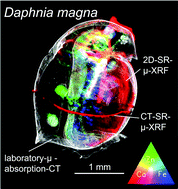In the field of environmental toxicology, the study on the effects of the presence of transition metals such as Cu, Ni and Zn on the health of pelagic and benthic invertebrates is an important research topic. Fast dynamic 2D micro-XRF scanning and dynamic XRF micro-CT experiments on D. magna, a frequently used ecotoxicological model organism, allow the quantitative investigation of the accumulation of metals within specific organs with microscopic resolution. K-means clustering allows comparison of the concentrations of the elements of interest between different tissues/organs. Principal component analysis allows most of the significant statistical variations in these large and complex multivariate data sets to be explained. Also, by combining SR-XRF and absorption CT data sets using appropriate software packages, it becomes possible to unravel the tissue-specific 2D/3D distribution of metals in-situ within delicate organic samples on the 3–15 μm resolution level in an essentially non-destructive manner.

You have access to this article
 Please wait while we load your content...
Something went wrong. Try again?
Please wait while we load your content...
Something went wrong. Try again?


 Please wait while we load your content...
Please wait while we load your content...